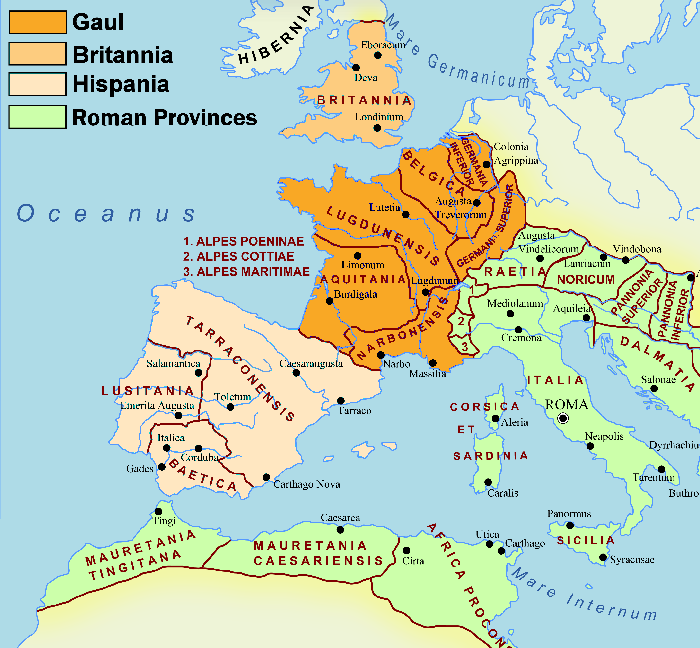|
 | Anglo Saxon History |  | |
| | The Roman Gallic Empire 260AD - 274AD |
|---|
| |
|---|
The Gallic Empire
|
|---|
From Wikipedia
The Gallic Empire or the Gallic Roman Empire are names used in modern historiography for a breakaway part of the
Roman Empire that functioned de facto as a separate state from 260AD to 274AD. It originated during the Crisis of the
Third Century, when a series of Roman military leaders and aristocrats declared themselves emperors and took control of
Gaul and adjacent provinces without attempting to conquer Italy or otherwise seize the central Roman administrative
apparatus.
The Gallic Empire was established by Postumus in 260AD in the wake of barbarian invasions and instability in Rome,
and at its height included the territories of Germania, Gaul, Britannia, and (for a time) Hispania. After Postumus'
assassination in 269AD it lost much of its territory, but continued under a number of emperors and usurpers. It was
retaken by Roman emperor Aurelian after the Battle of Châlons in 274AD.
Capital
Colonia Agrippina (Cologne) (260–271)
Augusta Treverorum (Trier) (271–274)[1]
Emperor (see empire map below)
260AD–269AD - Postumus (united Gaul, Britannia and Hispania)
269AD - Marius (only survived for a month or so)
269AD–270AD - Victorinus (Hispania support lost after Postumus's death)
270AD–274AD - Tetricus I (empire consisted of Gaul and Britannia)
| | |
|---|
Areas Controlled by the Gallic Empire
|
|---|

This map is a modified version from Wikipedia - Wikipedia
Gallic_Empire
| | |
|---|
| The End of the Gallic Empire |
|---|
The Battle of Châlons was fought between the Roman Empire commanded by Emperor Aurelian and the breakaway army of
Tetricus which was made up of Legionaries from the Rhine Army who were defending the Limes(defensive wall) in Germany.
The Battle was fought by Aurelians army of about 35,000 legionaries, 15,000 archers and slingers and 5,000 cavalry
and Tetricus army of possibly 60,000 to 90,000 men.
Aurelians troops although smaller in number were better trained as they were fighting legions, wheras Tetricus
troops were garrison troops who had been defending the German Limes(Roman border on the Rhine) and were not used to
direct battles.
Aurelian won and slaughtered the troops of Tetricus, the casualties were vast and although Aurelian lost 6,000 men,
Tetricus lost over 50,000 of the Rhine army.
Effect of the Battle
The Battle had a major effect on the Roman defences on the Rhine, as a large number of the garrison troops had been
lost, this made Aurelian's job controlling the area much harder as he had to replace these troops in a short space of
time. This in turn left the Rhine frontier dangerously defenseless and exposed to the invasions of Franks and Alemans.
The shortage of 50,000 garrison troops probably led to increased taxation and conscription in the tribal Belgae area
of modern Belgium.
This weakened the Roman control of Gaul and the lower Rhine which in turn created more unsettled political
conditions leading to the revolt by the Bagaudae in northern Gaul, Carausius's rise to power and the subsequent
temporary loss of control of Brittania by Rome.
| | |
|---|
| Recommended Reading |
|---|
Recommended
Books
(these are books I use for reference and link to Amazon pages) |
|---|
|
|
| | | |
| | |
| | |
| | |
| | |
| | |
| | |
| | |
| | |
| | |
| (As an Amazon
Associate, I may earn from qualifying purchases) |
|
|
|
|
|
| |
|
|
Local Interest
Just click an image |
|
|
|
|
|
|
|
|
|
|
|
|
| |
|
|